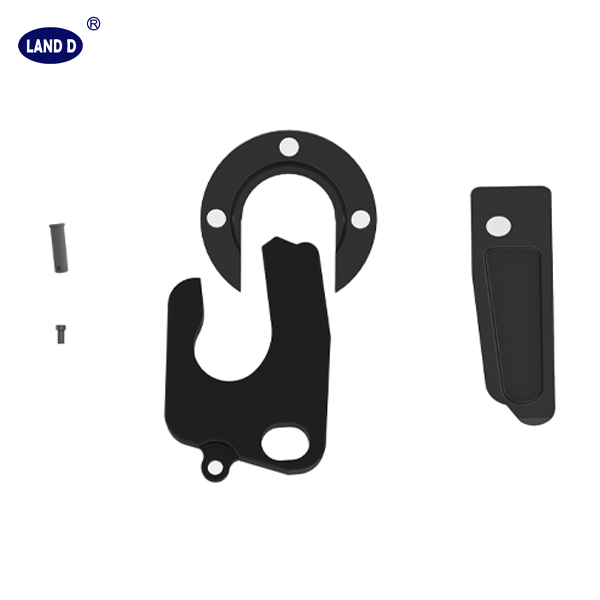Tout comme tout autre équipement de camionnage, fifth wheels nécessitent une régularité inspection, maintenance, and repair. Often, problems found during inspection can be attributed to the same component. Below, we’ll discuss what the most common fifth wheel repair is and give you some quick and simple tips for how to fix it.
JOST TAPE kits de réparation de cinquième roue 37C, pièces de remorque
QUELLE PIÈCE DE LA SELLETTE D'ATTELAGE A LE PLUS GÉNÉRALEMENT BESOIN D'ÊTRE RÉPARÉE ?
La pièce de la cinquième roue qui nécessite le plus souvent une réparation est la plaque supérieure. The top plate is a horseshoe-shaped plate that’s attached to the main frame of the vehicle. It offers trailers and cargo a secure connecting point for heavy loads.
Why is the top plate the most common fifth wheel repair? It’s under intense stress while in use. This high stress can damage the plate and normal wear can break down internal, smaller components like mâchoires de verrouillage et inserts de bague coussinée, bushings, release handles, and more to the point of replacement. You may also struggle with fifth wheel top plate troubles if your coupling attempts aren’t in compliance with JOST’s Operating Instructions or the industry standard TMC RMP-654.
Toutes ces possibilités montrent pourquoi il est essentiel de respecter les normes et d’être proactif en matière d’inspections et de maintenance.
DÉPANNAGE : COMMENT INSPECTER ET RÉPARER LA PLAQUE SUPÉRIEURE D'UNE SELLETTE D'ATTELAGE
Si vous avez un problème avec la plaque supérieure de votre sellette d'attelage, voici les étapes que vous pouvez suivre pour diagnostiquer et résoudre le problème.
1. REVIEW THE TOP PLATE’S SURFACE
Pull the release handle out and hang it on the release notch; it must be flat and straight. Then ensure the adjusting screw shows ⅜” to 1 ½” of threads. If it shows less or more than that, there is an issue.
If no issue is found, scrape any excess grease from the top plate surface’s recessed center. Check the cushion ring insert for any chipping or damage, and make sure the locking bar tip protrudes further into the throat than the coupling guide lugs.
2. EXAMINEZ LE LEVIER AVEC LA DOUILLE SOUS LA PLAQUE SUPÉRIEURE
You can also inspect your top plate and diagnose any issues by looking underneath it. First, verify that the lever with the bushing is in appropriate condition and position. Then check the pivot bolts to ensure there’s one washer between the lever and castellated nut on each of them. Finally, check the release handle attachments to ensure proper attachment.
3. UTILISEZ UN TESTEUR DE SERRURE POUR VÉRIFIER LE FONCTIONNEMENT
La troisième et dernière inspection consiste à utiliser un testeur de verrouillage pour vérifier le fonctionnement. Commencez par verrouiller la sellette d'attelage avec l'outil de test, puis vérifiez que la poignée de déverrouillage est en position verrouillée.Lien vers le document).
Notez également le positionnement de la mâchoire et de la barre de verrouillage. La mâchoire doit accepter le pivot d'attelage et pivoter complètement. La barre de verrouillage doit traverser complètement la gorge. Si l'une de ces positions est incorrecte, remplacez la mâchoire, le levier ou la poignée de déverrouillage endommagés.
Once you’ve determined what is worn or damaged, you can either fix or replace it.
Montre cette vidéo ou téléchargez ceci guide de dépannage pour plus d'informations, de visuels et de pièces de réparation de plaque supérieure couramment stockées chez JOST.
REPAIR VS. REPLACE: HOW TO KNOW WHEN IT’S TIME FOR A NEW FIFTH WHEEL
In many cases, a quick top plate repair can get your fifth wheel back and better than ever. However, there are some instances where a repair won’t do enough and it’s time to completely replace your fifth wheel.
Comment savoir quelle est la meilleure option ? Suivez ces conseils.
Réparer si :
- Votre plaque supérieure est encore en grande partie en bon état et une réparation rapide ou simple la ramènera à la normale.
- Votre plaque supérieure présente une certaine usure mais présente toujours de bonnes rainures de graissage et aucun dommage irréparable.
Remplacer si :
- La surface de votre plaque supérieure est usée jusqu'à la rainure de graissage à un moment donné (voir page 1, élément 1, figure 1 de ce document).
- Your top plate’s casting is cracked.


